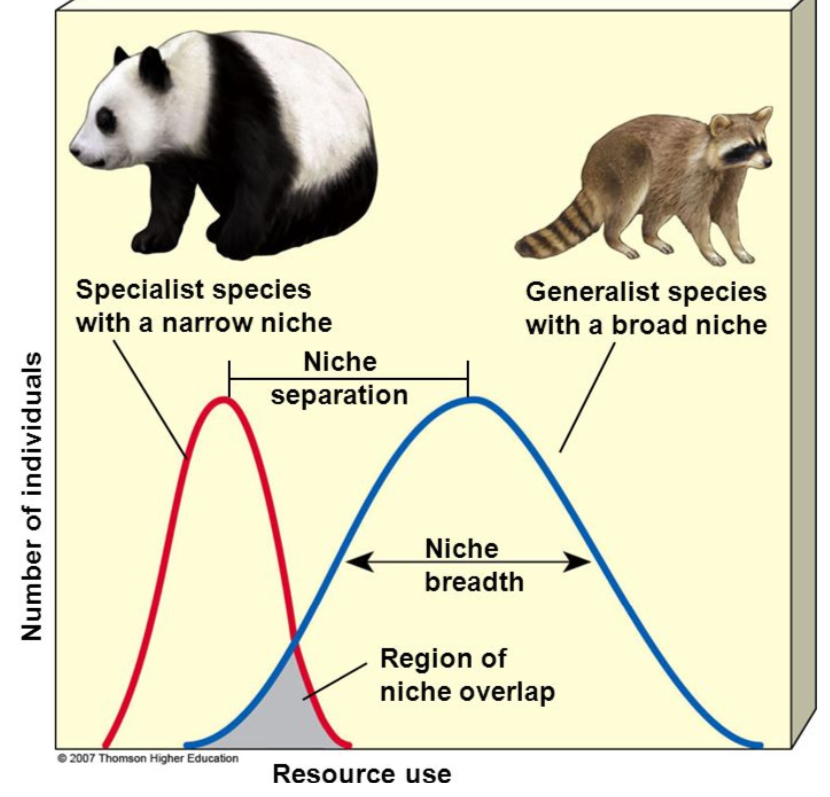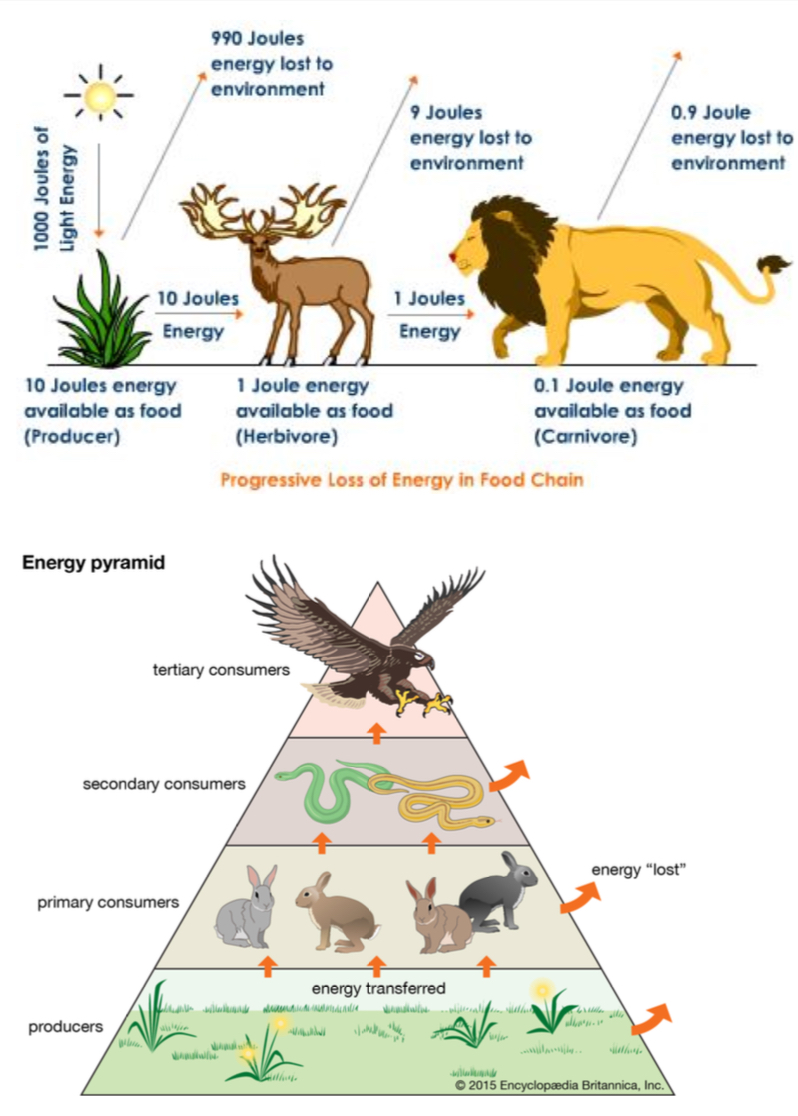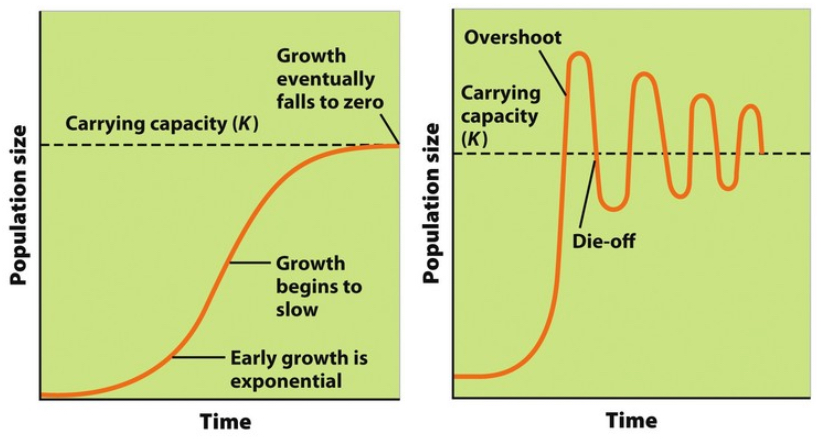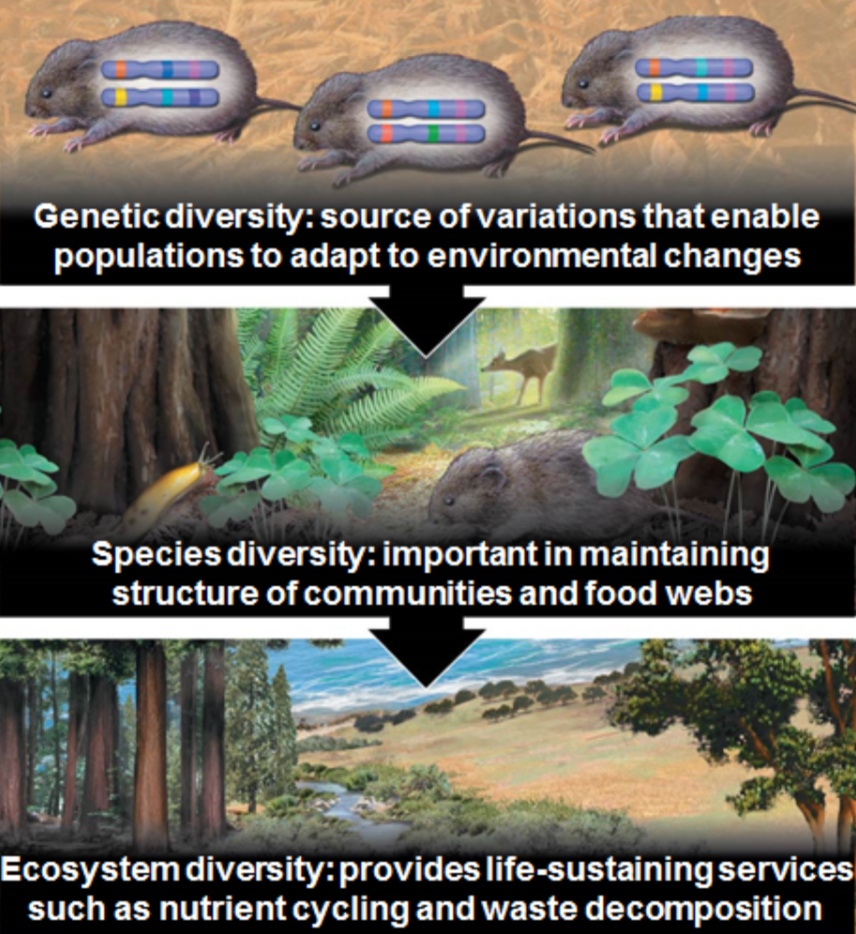🧬 AP Biology Unit 8
10-15% AP Weighting
Topics
8.1 Responses to the Environment
8.2 Energy Flow through Environments
8.3 Population Ecology
8.4 Effects of Density of Populations
8.5 Community Ecology
8.6 Biodiversity
8.7 Disruptions to Ecosystems
8.1 - Responses to The Environment
How Animals are Adapted to Their Environment
Specialists: Smaller range where they can survive, or narrower ecological niche makes them more prone to extinction
Specific food requirements (bamboo)
Less ability to adapt to new conditions
Generalists: Larger range where they cna live, broader niche makes them less prone to extinction & more likely to be invasive
broad food requirements
High adaptability

K-selected- “quality”
few offspring, heavy parental care to protect them
Usually reproduce many times over lifespan
Ex: most mammals, birds
Long lifespan, long time until to sexual maturity = low biotic potential = slow pop. growth rate
More likely to be disrupted by env. change or invasives
r-selected - “quantity”
Many offspring, little-to-no care
May reproduce only once
Ex: insects, fish, plants
Shorter lifespan, quick to sexual maturity = high biotic potential = high pop. growth rate
More likely to be invasive
Better suited for rapidly changing env. conditions
A Regulator is a type of organism that uses internal control mechanisms to control their internal environment despite external changes. This requires energy to do. Organisms adjust to the external environment with acclimation. This allows them to live in differing environments. Another word for this type of organisms is an Endotherm.
A Conformer is a type of organism whose internal environment depends on the external environment and will fluctuate with external changes. Some of these animals may regulate certain variables but conform to others. This allows them to use less energy for regulation. Another word for this type of organism is Ectotherm.
Both ectotherms and endotherms do thermoregulation, but ectotherms do it purely through things such as shivering. Anything organisms do to create energy is called thermogenesis. Endotherms use hormones to do thermogenesis by increasing metabolic activity.
Heat is transferred in four ways and organisms have adapted to take advantage of them. For example, a lizard on a rock is taking advantage of radiation and conduction.
Radiation
Heat from the sun or a fire is transferred to an organism through electromagnetic waves
Convection
Heat is transferred by the movement of air.
The heat from the air is transferred through physical touch
Evaporation
As water evaporates, energy is released to break the hydrogen bonds, which cools whatever it is evaporating off.
The energy (heat) is taken from the “host” for the hydrogen bonds to be broken.
Conduction
The transfer of heat between two things through physical contact
Ex: warming a cold metal chair by sitting on it
Countercurrent flow helps prevent heat loss to the environment instead passing it back off to blood that needs to be warmed,

Other ways organisms conserve heat is through shivering, insulation, or behavioral responses such as curling in a ball or sleeping in a pile.
Metabolic rate is the amount of energy an organism uses in a unit of time. It is determined by measuring an organism’s heat loss, the amount of energy being consumed, the amount of carbon dioxide being produced, or by measuring the energy content of food consumed and energy lost in waste products. Endothermic animals have a basal metabolic rate (BMR) that is measured at rest in a comfortable temperature. Ectotherms have a standard metabolic rate (SMR) that is measured at rest in a comfortable temperature. Both measurements assume the animal is not growing, fasting, or stressed. Endotherms have a higher metabolic rate than ectotherms.
Metabolic rates are proportional to body mass to the power of 3⁄4 (M ¾). So, smaller organisms have a higher metabolic rate per gram.
Animal Behaviors (How Animals Behave in Response to Their Environment)
There are four key questions that are asked to explain animal behavior.
What is the stimulus and what is its physiological mechanism that mediates the response?
How does an animal's experiences during growth/development affect its behavior?
Does the behavior aid survival and reproduction?
What is the behavior's evolutionary history?
Fixed action patterns are not learned, that are instincts. They are triggered by a sign stimulus and cannot be changed. Innate behavior is a reflex.
Pheromones are used to communicate.
Learning:
Imprinting is the establishment of a long-lasting behavioral response to an individual or object, such as humans. It differs from other types of learning because it occurs during a sensitive period, which is a developmental phase which is the only time certain behaviors can be learned.
Spatial learning is complex learning based on an experience with an environment.
Associative Learning is when animals associate something with something else, such as a ringing bell meaning food.
Social Learning is learning through observing others.
Classical Conditioning - A random stimulus is associated with a reward or a punishment.
Operant Conditioning (Trial and Error learning) - An animal associated their own behaviors with a reward or punishment
Proximate Causation
How a behavior occurs or is modified, based on a current individual and their situation.
Ex: A frog pees when it is picked up. It pees because it is picked up.
Ultimate Causation
Why a behavior exists from an evolutionary standpoint.
Ex: A frog pees when picked up because animals may drop them, increasing their fitness.
Taxis, similar to plant’s tropisms, is the movement towards or away from a stimulus, like a moth moving towards light. Kinesis is undirected movement in response to a stimulus. Turning and different speeds can happen. One example of this is a Rolly Polly who is exposed to light (Stimulus) will run in random directions for somewhere dark to hide.
8.2 - Energy Flow
1st Law of Thermodynamics - Energy is never created or destroyed
Biogeochem cycles demonstrate conservation of matter (C/N/H2O/P)
Food webs demonstrate conservation of energy
Ex: When a rabbit eats a leaf, the energy from the leaf (glucose) is transferred to the rabbit & stored as body tissue like fat/muscle
Each time energy is transferred, some of it is lost as heat
Applied to food webs: the amount of usable energy decreases as you move up the food chain (organisms use up most of it for movement, development, etc.)
Because *available* energy decreases with each step up the food chain, a trophic pyramid (troph = nourishment or growth) is used to model how energy moves through an ecosystem
10% Rule: in trophic pyramids, only about 10% of the energy from one level makes it to the melt level; the other 90% is used by the organism or lost as heat
Tertiary Consumers: animals that eat secondary consumers or carnivores & omnivores (aka - top/apex predators)
Secondary Consumers: animals that eat primary consumers or herbivores (aka - carnivores & omnivores)
Primary Consumers: animals that eat plants (herbivores)
Producers (plants): “produce”- really convert sun’s light energy into chemical energy (glucose)
The 10% rule also applies to biomass (or mass of all living things at each trophic level) Since energy is needed for growth & only 10% of energy transfers from one level to the next, only 10% of the biomass can be grown/supported.
To calculate biomass or energy available at the next level up, move the deck cal place to the left (or divide by 10)

To calculate biomass or energy available at the next level up, move the deck cal place to the left (or divide by 10)
8.3 - Population Ecology
Population Ecology the study of the size/distribution/density of populations and how these populations change over time
Important statistics for understand a population
Birth rate - offspring produced in a period of time.
Death rate - number of deaths in a period of time.
Sex ratio - proportion of males and females in a population.
Age structure - statistic that compares the relative number of individuals in the population from each age group.
Generation time - time needed for individuals to reach reproductive maturity.
Immigration rate - Rate at which individuals move into a given population.
Emigration rate - Rate at which individuals move out of a given population.
Carrying Capacity (k): the max. Number of individuals in a pop. that an ecosystem can support(based on limiting resources)
Fig. 1 is theoretical
Fig. 2 is more realistic
Pop. briefly “overshoots” (k) and then die-off happens

Highest Population an ecosystem can support based on limiting resources:
Food
Water
Habitat (nesting sites, space)
Overshoot: when a population briefly exceeds carrying capacity
Ex: deer breed in fall, give birth all at once in spring; sudden spike in pop. = overshoot
Consequence of overshoot: Resource depletion ex: overgrazing in deer
Die-off: when resource depletion (overshoot) leads to many individuals dying
Ex: many deer starve with too many new fawns feeding in spring
Survivorship Curves: line that shows survival rate of a cohort (group of same-aged individuals) in a pop. from birth to death
Faster drop in line = quicker death/life span of individuals
Slower drop in line = longer life span

Type I (mostly K-selected)
High survivorship early in life due to high parental care
High survivorship in mid life due to large size and learned defensive behavior
Rapid decrease in survivorship in late life as old age sets in
Ex: most mammals
Type II (mostly K-selected)
Steadily decreasing survivorship throughout life
Type III (mostly r-selected)
High morality (low survivorship) early in life due to little to no parental care
Few make it to midlife; slow, steady decline in survivorship in midlife
Even fewer make it to adulthood; slow decline in survivorship in old age
Ex: insects, fish, plants
8.4 - Population Density
Population is a certain species that live in the same general area.
Reproduction and immigration increase a population while emigration and death decrease a population. This equation is (B+I) = (D+E)

Distribution patterns:
Random - Individuals are randomly distributed across their environment
Clumped - Individuals live in groups that are spaced out from each other
Uniform - Individuals are evenly spaced out across their environment
Density-Dependent Factors: factors that influence pop. growth based on size:
Ex: food, competition for habitat, water, light, growth based on size
All of these things limit pop. growth based on their size; aka - small pop. don’t experience these, large do
Density-independent: factors that influence pop. growth independent of their size
Ex: natural disasters
(flood, fire, tornado, hurricane)It doesn’t matter how big or small a pop. is, natural disasters limit them both
Resources partitioning: different species using the same resource in diff. ways to reduce competition
Temporal partitioning: using resource @ different times, such as wolves & coyotes hunting @ different times (night vs. day)
Spatial partitioning: using diff. areas of a shared habitat (diff. length roots, live in different trees)
Morphological Partitioning: using diff. resources based on diff. evolved body features
8.5 - Community Ecology
Forms of Species Interaction
Symbiosis - A symbiotic relationship is one between two different species that can be classified as one of three main types: commensalism, mutualism, or parasitism.
Commensalism (+/_) - One organism benefits while the other is unaffected.
Mutualism (+/+) - Both organisms are benefited.
Parasitism (+/-) - One organism benefits by hurting the other
Competition (-/-) - Both species are harmed by this kind of interaction. The two forms of competition
Intraspecific competition is within species competition.
Interspecific competition is between different species.
Predation - One species kills and eats another species
Defense Mechanisms
Aposematic coloration - Bright colors act as a warning sign to animals, used by animals that possess a chemical defense mechanism.
Predators have grown cautious of animals with bright color patterns due to past encounters
Cryptic coloration (camouflage) - those being hunted develop a color scheme that allows them to blend into the environment
Batesian mimicry - an animal that is harmless evolves to look like an animal that is dangerous to trick predators.
Mullerian Mimicry - two species, often aposematically colored, mimic each other’s color scheme in an effort to increase predators avoiding them. The more often predators see dangerous prey with this coloration the faster they learn to avoid them.
Succession is a series of predictable stages of growth that a forest goes through. There are tewo types of succession.
Primary Succession: starts from bare rock in an area with no previous soil formation. Moss & lichen spores carried by the wind grow directly on rocks, breaking them down to form soil.

Secondary Succession: starts from already established soil, in an area where a disturbance (fire/tornado/human land clearing) cleared out the majority of plant life. Grasses, sedges, wildflowers, and berry bushes have seeds dispersed by wind or animal poop

Pioneer species appear first, when the ground is simply bare rock, or bare soil after a disturbance. Characteristics: seeds spread by wind or animals, fast growing, tolerant of shallow soil and full sunlight Ex: moss, lichen (bare rock), wildflowers, raspberries, grasses/sedges
Mid-successional species appear after pioneer species have helped develop deeper soil with more nutrients by their cycles of growth/death. Characteristics: relatively fast growing , larger plants that need deeper soil with more nutrients than pioneers, sun tolerant. Ex: shrubs, bushes, fast-growing trees like aspen, cherry, and pine
Late successional or climax community species appear last, after soil is deepened and enriched with nutrients by cycles of growth and death by early & mid successional species. Characteristics: large, slow-growing trees that are tolerant of shade and require deep soils for large root networks. Ex: maples, oaks, other large trees
Primary
Occurs in an area that hasn’t previously been colonized by plants (bare rock)
Ex: volcanic rock, rock exposed after glacial retreat
Moss and Lichen (spores dispersed by wind) are able to grow directly on rock by
Secreting acids that break down rock & release mineral containing nutrients they need (N/P/K)
Chemical weathering of rocks by moss & lichen combined with organic matter from moss & lichen dying from some initial shallow soil
Secondary
Occurs in an area that already has established soil, but has had most plant life removed by a disturbance.
Pioneer species are still wind-dispersed seeds of plants that are fast-growing and sun-tolerant, but bushes/grasses/flowers instead of moss/lichen
Soil is already established & sometimes even enriched by nutrient-rich ash from fire; overall more rapid process than primary succession
8.6 - Biodiversity
There are three types of diversity.

Biodiversity increases the resilience of the population. It is more likely to survive environmental changes, new predators and disease.
8.7 - Disruptions to Ecosystems
Invasive Species
Species not native to an area, introduced often by human transport
No natural predators to control pop.
Highly competitive (aggressive feeders or fast growers) for resources
Can thrive in their non-native habitats
A Natural Disturbance is an event that disrupts the structure and or function of an ecosystem (Ex: tornadoes, hurricanes, asteroids, forest fires, drought) Natural disturbances can be even greater than human disruptions. These can occur on periodic, episodic, or random time frames.
Periodic: occurs with regular frequency
(ex: dry-wet seasons)
Episodic: occasional events with irregular frequency
(ex: droughts)
Random: no regular frequency
(ex: volcanoes, earthquakes, asteripods)
Earth’s climate has varied over geological time for numerous reasons (Ex: Slight changes in earth’s orbit & tilt cause mini ice ages & warmer periods) Sea level has varied over geological time as glacial ice on earth melts & forms.